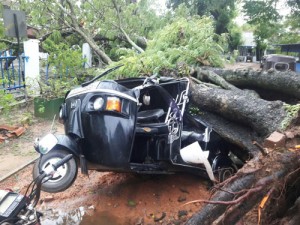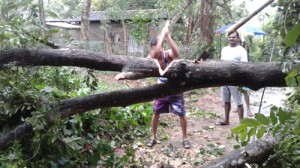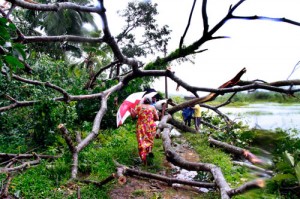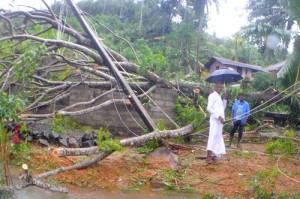News
‘Treetise’ to prevent Colombo’s shade from casting a shadow
The winds that buffeted the Western Province this week, not only brought down hoardings, walls and roofs, but also felled trees which added to the damage. Some trees were uprooted while others snapped. Was this a disaster waiting to happen, and will it occur again?

Matara
The Colombo Municipal Council’s (CMC) Tree Maintenance Dept (TMD) tasked with pruning and removing tree debris, lacks even basic information such as how many trees make up the urban forest density. There has been no empirical survey of which trees pose a threat to the public.
“Despite the lack of information, the TMD often trims trees to reduce risks. But, when they do this, people and groups opposed to tree-cutting, lodge complaints,” said Works Supervisor Shane Rodrigo.
“Employees have been arrested and hauled to police stations over ‘false complaints’,” echoed Deputy Director of Engineering, Tharanga Gunaweera. “What we are trying to do is to reduce the dangers during bad weather, like what we experienced,” she said.
However, what professional conservationists oppose is haphazard actions against trees. Ruk Reka Ganno is a 45-year-old society founded by Irangani Serasinghe, dedicated to the protection of trees. The veteran artiste said, “Trees should be planted in the right places.”
“Houses and people do get affected by lack of maintenance,” she agreed. “Trimming or balancing, however, must be done under supervision of people who know the job. There is a scientific way of cutting a branch and treating the cut, which is not followed at present,” she said.
Colombo has a large spread of trees planted by the British. Ruk Reka Ganno once volunteered its expertise for a tree-maintenance project near Royal College. But it died instantly, as the CMC did not offer staff and finances. “The solution is trimming under expert supervision,” she reiterated,.
“Tree management isn’t about planting trees. It is about maintaining them after they are planted,” says ecologist and former Senior Arborist at the Singapore Botanic Garden, Lahiru Wijedasa. This includes soil, fertiliser management, leaf litter management, as well as pruning till they are finally removed.
“A tree must be looked at as an entire organism, similar to how the health of a human being is assessed. The roots provide nutrients and support; the trunk and branches, structural support between the roots and leaves; the leaves, food and protection. Tree health depends on a balance of all the above,” said Mr Wijedasa, who is reading for a PhD in Forest Ecology at the National University of Singapore.

Aluthgama - Trees that came down in the provinces
“The root system is vital, playing a dual role of absorbing nutrients and water, while maintaining stability. Most tree failures are traced to problems with the roots. There must be enough soil, with a regular supply of nutrients and organic matter, for the roots to grow in. Particular care must be paid to preventing soil compaction by pedestrians, vehicles and water logging, all of which can reduce area for roots to occupy.”
“This is particularly the case for most roadside trees in Colombo where you can hardly see tree roots. Most of the rooting areas have been paved over. Activities which compromise this root zone will compromise the tree structure. If you remove one leg of a four-legged chair, it can still stand. But the minute weight is applied to it, the chair falls. The same concept applies to tree roots, with the most common culprit being construction and compaction,” he said.
In urban areas, trees and roots inevitably share the same area with services such as electricity, water and drainage. Changing and maintaining these services will disrupt and even kill root systems. However, the effect might become evident many years after the disturbance. The best prevention is long-term planning.
The most visible tree failures are in tree trunks and branches. Such failures are natural and trees have the ability to self-prune. “This is nature’s way of ensuring a tree has an optimum shape and form as weak branches fail and are removed,” Mr Wijedasa said.
But such natural branch failures in cities are a risk to pedestrians, making artificial maintenance a necessity, with tree branches being pruned well in advance of any potential failure. “Getting this right is an important aspect of urban forestry,” he said.

Dodanduwa
In general, pruning should be avoided as much as possible. “Remember, everything a tree does is for a reason,” Mr Wijedasa pointed out. “Every plant is in balance. Artificially removing any part of this plant disturbs that balance.”
Cuts should be made in specific locations where trees would naturally self-prune. Particular attention must be paid to how much living tissue is removed. Younger trees can recover faster and better from injuries such as living tissue removal. Older trees will not recover well from pruning.
“Any tree management plan must be based on reducing pruning for older trees over time,” he said.

Mahawila

